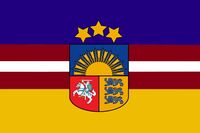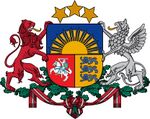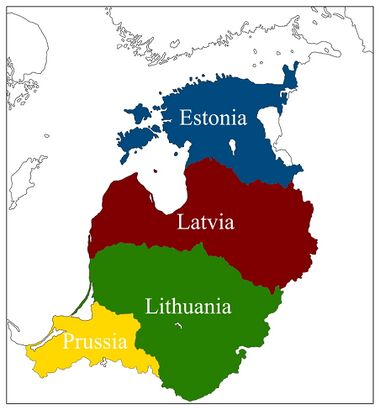Baltic Commonweal: Difference between revisions
No edit summary |
|||
| Line 59: | Line 59: | ||
|GDP_nominal_year = 2020 | |GDP_nominal_year = 2020 | ||
|GDP_nominal_per_capita = 20,361 | |GDP_nominal_per_capita = 20,361 | ||
|Gini = | |Gini = 35.2 | ||
|Gini_year = 2020 | |Gini_year = 2020 | ||
|HDI = 0.974 | |HDI = 0.974 | ||
Revision as of 11:18, 21 December 2020
Baltic Commonweal Baltijas Sadraudzība | |
|---|---|
| Motto: "Pro libertate atque independentia" | |
| Anthem: "Awake, Baltics!"
"Atmostas Baltija, Bunda jau Baltija, Ärgake Baltimaad!" | |
Four Baltic Republics | |
| Capital and largest city | Rīga |
| Official languages | German |
| Recognised national languages | Latvian, Lithuanian, Estonian |
| Ethnic groups (2020) | Latvians (36.5 %) Lithuanians (33.9 %) Estonians (24.3 %) Russians (2.2 %) Polish (1.7 %) Belarusians (1.3 %) Ukrainians (0.1 %) |
| Demonym(s) | Balt, Balts |
| Government | Federal Constitutional Parliamentary Republic |
• Federal President | Sandra Alunāne |
• Prime Minister | Antanas Paulauskas |
• Speaker of the Saeima | Raimond Tamm |
• Chief of Justice | Aldona Butkutė |
| Legislature | Federal Saeima |
| Foundation | |
| Area | |
• Total | 238,410 km2 (92,050 sq mi) |
• Water (%) | 5.6 % |
| Population | |
• 2020 estimate | 21 489 255 (59th) |
• 2015 census | 20 952 087 |
• Density | 90/km2 (233.1/sq mi) |
| GDP (PPP) | 2020 estimate |
• Total | 1.015 trillions |
• Per capita | 47,253 |
| GDP (nominal) | 2020 estimate |
• Total | 437.5 billions |
• Per capita | 20,361 |
| Gini (2020) | 35.2 medium |
| HDI (2020) | 0.974 very high |
| Currency | Baltic Krona (BLK) |
| Time zone | UTC+ 2, + 3 in summer (EET) |
| Date format | yyyy.mmm.dd. |
| Driving side | right |
| Calling code | +370 |
| ISO 3166 code | BLT |
| Internet TLD | .bl |
The Baltic Commonweal of Democratic Republics(Baltijas Demokrātisko republiku sadraudzība [baltijas demokra:tisko republiku sadrau dʒi:ba]), commonly referred to as the Baltic Commonweal or the Baltic, is a democratic federal state in Eastern Europe with an area of 238,410 km2 and a population of 21,489,255 as of 31 December 2020. In the south, the Baltic borders with the Republic of Poland, in the southeast with the Republic of Belarus, in the east with the Russian Federation. In the north it is washed by the Baltic Sea.
The form of government is a constitutional parliamentary republic. The Federal President since 3 August 2017 is Sandra Alunāne from the SDPB party, since 26 April 2017 Antanas Paulauskas has been the Prime Minister and Head of Government from the Reform Party.
The capital and the largest city is Rīga. The state language is German.
The Baltic Commonweal consists of four unitary republics that have equal rights in the Commonweal, these are the Republic of Latvia, the Republic of Estonia, the Republic of Lithuania and the Prussian Republic (until 1961 the Republic of East Prussia). Each republic is divided into counties (lat. Novads, lit. Apskritis, Est. Maakond). The Republic of Estonia is divided into 16 counties, the Republic of Latvia is divided into 22 counties, the Republic of Lithuania is divided into 13 counties, the Prussian Republic is divided into 4 counties. The total number of counties in the Commonweal is 55 counties.
The Baltic Commonweal is also a member of the United Nations, NATO and the Scandinavian Economic Bloc (the trade and economic bloc of the Scandinavian countries and the Baltic Commonweal, which are not members of the European Union).
Etymology
History
Geografy
Relief
Climate
Environment
Demographics
Religion
Ethnicity
Language
Health
Education
Largest Cities
State structure
Administrative division
Government
Executive power
Legislature
Judicial branch
Political parties
Migration policy
After a series of terrorist acts in the world, the government has consistently tightened immigration laws. Anti-immigration measures have significantly reduced the inflow of certain categories of migrants to Baltic Commonweal. In particular, in 2018, 4198 entry permits for family reunification were issued, which is 70% less than in 2013, and 1038 people were granted political asylum (82.5% less). At the same time, over the period 2013-2018, the number of those who received a study visa increased from 10 to 28.4 thousand people (an increase of 2.8 times), and those who entered on a work visa - from 5.9 to 12.8 thousand people (an increase 100%). In 2019, the measures were further tightened - in particular, a point system was introduced for spouses of immigrants wishing to enter the country.


